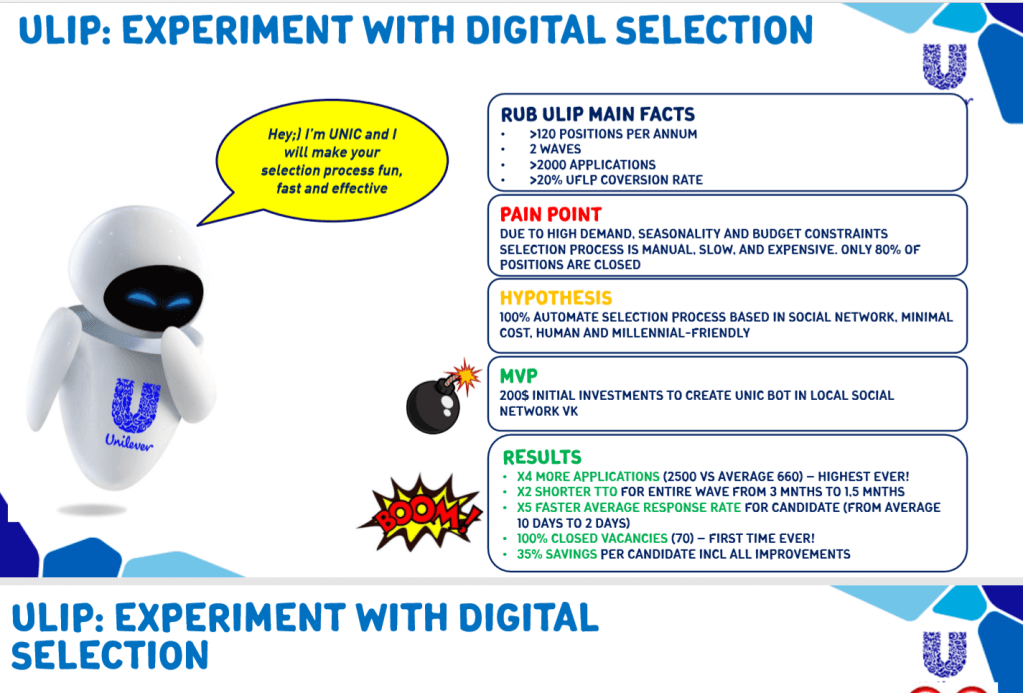We continue to publish reports on the HR-Digitalisation Conference. Head of HR department at Unilever, Evgenia Popovidchenko talked about how HR-bots can be used to automate human resource management.
We have been implementing the HR-digitalisation project since 2016 with the support of our partner company, which has expertise in the robotic process automation (RPA). And we evaluate all changes in personnel processes – from recruitment to remuneration, as a whole: what can be optimised, automated, where and which technologies are applicable and what effect they can have. We use the ESOAR methodology to discuss these problems: ESOAR stands for Eliminate, Standardize, Optimize, Automate, Robotize.

Tasks are divided into projects and subprojects and are detailed to the required level. This discussion is conducted in a workshop format – usually taking 3-5 days, and the result is a specific list of tasks that need to be solved in a particular project. For two years (2017-2018), robotic process automation allowed us to cut on the costs of such tasks as data processing, management of dismissal processes, VHI payments processing, – by a total of 82,000 euros.
The fact that Unilever is a global company makes it necessary to ensure that the processing of Russian data complies with local legislation. Integration of the parent company’s systems with the Russian division was an important and difficult task. Historically, we transferred a significant part of the data manually due to the significant difference in system interfaces. The robots took over the part of manual operations.
What changed? For example, an employee of the HR-department used to take up to 13 minutes just to enter data on an employee’s dismissal into the local system. The HR-bot takes only 3 minutes to complete the same task; it also has a lower risk of error. On a company scale, this difference in minutes adds up to hours and, ultimately – to money that the business saves through automation.
We have achieved even more impressive results as a result of the robotic process automation of life insurance and voluntary medical insurance. Here, a task that took an employee about 50 minutes to complete now takes the robot just 1 minute.
A trial on the selection of young employees for an internship programme that was ‘entrusted’ to the bot produced interesting results. Aimed at forming an internal personnel reserve, this programme typically lasts 3 months and is held twice a year. The main hypothesis confirmed in this project is that to attract young candidates, our company must think the same way as they do: be creative, memorable, and open for interaction in already familiar formats on popular social networks. HR previously found the task of selecting interns quite complicated, as applicants are required to meet diverse criteria. The selection process proved to be slow and costly, and the HR department closed only 80% of the business requests in time. It was very important to raise this indicator in the shortest time possible. What did the bot integration trial achieve? We were able to collect four times more applications, closed 100% of applications, responded to candidates five times faster and overall cut cost of this task by 35%. At the same time, it cost only US$200 to launch bots.
I must say that we not only robotised the selection process, but also made it more interesting for applicants. Those who passed the first stage of selection were able to record a video presentation. This video message was organised with the support of VCV, whose service we have integrated into our HR processes.
What led to this success?
First, the very fact of the popularity of bots: users interact with them in exchanges on personal matters, and it is also familiar and convenient for them as a tool for solving work-related tasks.
Secondly, we were able to analyse our audience and see that, for example, students in the regions are much less prepared for online formats, are not so well oriented, and prefer internship work at the enterprise.
Thirdly, we realised that the older generation of managers is not quite as integrated into Internet-based communication, for example, they find it a bit uncomfortable to work with video interviews. It is important to help these managers and employees master these tools in addition to traditional formats such as telephone or face-to-face interviews.
- Telegram
- ВКонтакте



